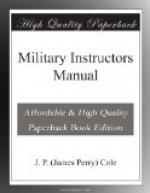LESSON 1. (CLASS ROOM—FOUR HOURS.)
Problem—Map Reading.
Study the conventional signs found in the “Manual for Non-commissioned Officers and Privates of Infantry of the Army of the U.S.,” 1917, page 273, or in Grieves, pages 28-35. These conventional signs are not universal and must be used only as indications of the general practice.
In map sketching in the field few conventional signs are used, and the items of importance are written on the map, such as WOODS, CULTIVATED, HEDGE, SWAMP, etc.
TAKING UP MAP SCALES.—There are three ways of indicating the relation between the actual distance on the ground and the space the same distance occupies on the map:
1. The graphic scale is a straight line divided into units, as miles, yards, feet or meters, which represents the actual ground distance. Thus if 6” = 1 mile the line would be six inches long and marked at one end and 1 mile at the other, three inches being marked 1/2 mile, etc. It is important to always have this graphic scale on a map so that if the paper gets wet or is stretched from its original size the scale will change in the same proportion.
2. A Statement in words or figures, e.g., 3 inches equal one mile, meaning that 3 inches measured anywhere on the map represent 1 mile on the actual ground.
3. The Representative Fraction (generally known abbreviated as R.F.) having a number above the line that shows the unit length on the map and below the line the number of units which are in the corresponding actual ground distance. For example, if 1” = 1 mile, then the R.F. is:
1” (map distance) ----------------------------------- 63,360” (1 mile—ground distance)
if 3” = 1 mile the R.F. is:
3”
(map distance) 1
-----------------------------------
or -------
63,360”
(1 mile—ground distance) 21120
if 6” = 1 mile:
6”
1
--------
or -------
63360”
10560
if 12” = 1 mile:
12”
1
---------
or ------
63360”
5280
In reading a map one must know the scale and also where the North is. This is always indicated by an arrow pointing either to the magnetic North or the true North. If to the magnetic North the needle will have but one barb away from the true North. The angle between the magnetic and the true North is the declination.
Placing the map in proper relation to the ground so that points of the compass coincide on map and ground is called orienting the map.
In map work there is one vital point to remember; practically all the ground surface is in its present form as a result of water action




